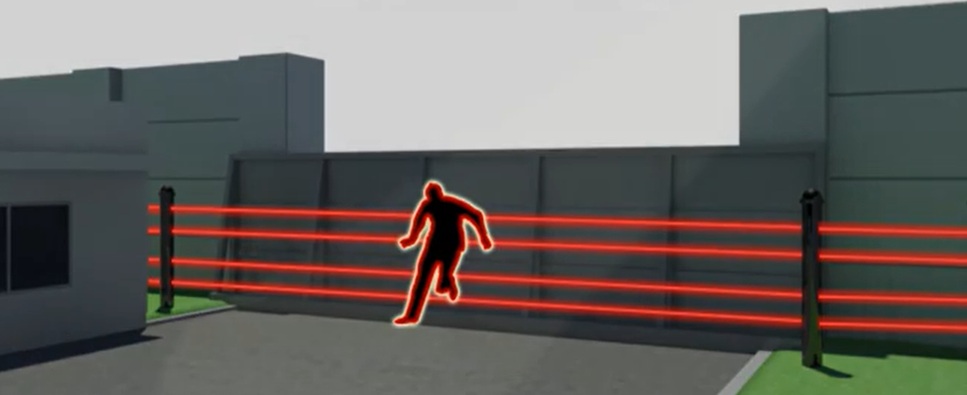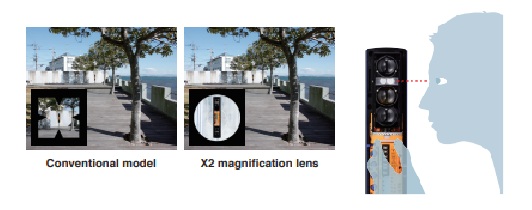A Comprehensive Guide to Photobeam Sensors for Perimeter Security
What is a Photobeam Sensor?
A photobeam sensor is a security device that detects the passage of people or objects using active infrared beams. Commonly installed along outdoor perimeters or building boundaries, it enables early detection of intruders and facilitates prompt response by integrating with alarm systems and surveillance cameras.
Photobeam sensors come in various models, including short-range and long-range types, as well as versions designed to operate reliably under harsh weather conditions. This allows users to select the most suitable sensor based on the specific application and site requirements.
In this article, OPTEX provides a clear and detailed explanation of how photobeam sensors work, the different types available, and how to choose the right model depending on your environment and needs.

Principle and Key Features of OPTEX Photobeam Sensors
In a typical opposing-type photobeam sensor system, the transmitter emits an infrared beam that is received by the receiver. When a person or object physically interrupts this beam, the system instantly detects the intrusion and triggers an alarm.
Key Features of OPTEX Photobeam Sensors:
- Long-range detection capability (models available for up to 200 meters)
- Available in both wired and wireless versions
- Proprietary technology to minimize false alarms caused by environmental factors, small animals, and weather conditions
- Easy optical axis alignment functions for reduced installation time (SL Series)
- High-sensitivity design ensures stable detection even in extreme weather conditions such as severe cold or intense heat
- Immediate notification of reduced detection performance due to fog or rain (trouble signal output via D.Q. circuit)
- Flexible installation options for various environments (walls, fences, poles, etc.)
Advantages of Photobeam Sensors in Security Applications
Photobeam sensors play a vital role in protecting premises by enabling early detection of intruders. When installed along the perimeter or boundary of a building, Photobeam sensors can detect the moment an intruder crosses the protected area and immediately trigger an alarm.
These sensors serve as a critical component in security systems, allowing for rapid detection and seamless integration with alarms and surveillance cameras to ensure immediate response.
OPTEX offers a wide range of products tailored to various applications and installation environments, and has earned the trust of customers around the world through its proven performance and reliability.
Choosing the Right Photobeam Sensor Based on Installation Environment and Requirements
The optimal photobeam sensor varies depending on the installation site and intended purpose. Use the following criteria to help select the most suitable model for your needs.
OPTEX offers a comprehensive lineup designed to meet a wide range of environments and requirements.
1. Selecting a Model Based on Detection Distance
- Perimeter Protection
For monitoring large premises or boundary lines, long-range opposing-type photobeam sensors are ideal.
OPTEX provides models with detection ranges up to 200 meters (e.g., SL-650 Series), allowing wide-area coverage with fewer units.
- Narrow Pathways and Entrances
In areas where reliable detection is needed over short distances, mid-to-short-range models are effective.
These sensors are also suitable for locations with limited installation space, offering flexible deployment options.
2. Selecting the Right Product Based on Environmental Conditions
Choosing a product suited to the installation environment ensures long-term stable operation and high reliability.
- Areas with Frequent Fog or Rain
To maintain stable detection even in low-visibility conditions, models equipped with high-sensitivity design and D.Q. circuits are highly effective.
OPTEX’s SL-200/350/650QDM models feature A.T.P.C. (Automatic Transmitter Power Control), which automatically adjusts and optimizes the infrared beam output based on surrounding environmental conditions.
This function helps reduce false alarms and missed detections caused by fog, frost, crosstalk, or light saturation.

- Locations with Strong Direct Sunlight or Ambient Light
Models equipped with Sunshine Protection technology suppress false alarms caused by sunlight or reflected light.
OPTEX’s SL-QDP and SL-QDM series use triple-layer optical filters to prevent false alarms even under intense direct sunlight, ensuring high reliability in outdoor environments.
- Regions with Frequent Lightning Strikes
In areas prone to lightning, models with lightning-resistant design are recommended.
Some OPTEX products include lightning protection features that reduce the risk of malfunction or damage caused by electrical surges.
Wireless models are also effective, as they are less susceptible to lightning-related issues due to the absence of wired connections.
▶ Wireless models: SL-350QFR/SL-350QNR, SL-100TNR/SL-200TNR
- Locations concerned False Alarms from Birds or Falling Leaves
Using quad-beam sensors instead of twin-beam sensors can significantly reduce false alarms caused by birds or falling leaves.
Quad-beam sensors trigger an alarm only when all four beams are interrupted simultaneously, resulting in higher detection accuracy.

3. Selecting the Right Product Based on Operational Needs
- When Installation Time Needs to Be Minimized
Models equipped with features that support optical alignment can significantly improve installation efficiency.
OPTEX’s SL Series includes helpful tools such as LED indicators that display alignment levels and the Sniper Viewfinder, which assists with precise optical alignment.
In particular, the SL-200/350/650QDM models allow alignment level checks on the transmitter side, enabling one-person installation.- Sniper Viewfinder:
This viewfinder features a lens with twice the magnification compared to conventional models, greatly enhancing visibility during optical alignment.
Even in long-range installations, it enables quick and accurate setup while maintaining stable performance.
- Sniper Viewfinder:

- When Want to Minimize False Alarms
Products that incorporate quad-beam structures and Double Modulation technology help reduce false detections caused by small animals, sunlight, and ambient light interference.
- When Expanding Vertical Detection Coverage to Prevent Missed Intrusions
In high-security areas or critical facilities, it is essential to enhance vertical surveillance to avoid blind spots and missed detections.
By stacking multiple sensors vertically (stacking installation), the detection area can be extended upward and downward, eliminating gaps in coverage.
OPTEX’s SL-QDP and SL-QDM series support four-channel frequency switching for infrared beams, which prevents interference between sensors during stacking installations.
FAQ
1. Can OPTEX Photobeam Sensors Be Used Outdoors?
Yes, OPTEX photobeam sensors are specifically designed for outdoor use and can operate reliably even in harsh conditions such as rain, fog, and dust. To maintain stable detection performance, certain models are equipped with the following advanced features:
- Trouble Signal Output via D.Q. Circuit: Instantly alerts users when detection performance is affected by severe weather conditions such as dense fog, heavy rain, or snow.
- Sunshine Protection Technology: Triple-layer optical filters prevent false alarms caused by strong direct sunlight. (Available in SL-QDP / SL-QDM series)
- A.T.P.C. (Automatic Transmitter Power Control): Automatically adjusts and optimizes the infrared beam output based on environmental conditions, helping to reduce false alarms and missed detections caused by fog, frost, crosstalk, or light saturation. (Available in SL-QDM series)
2. I'm concerned about false alarms. Are there any countermeasures?
Yes, OPTEX products incorporate proprietary technologies such as quad-beam structures and Double Modulation (available in SL-QDP / SL-QDM series), which help minimize false detections caused by birds, falling leaves, wind, and other environmental factors.
3. Do I need to hire a professional installer for setup?
We recommend having the system installed by a professional.
Proper optical alignment and installation tailored to the environment require specialized knowledge and experience.
OPTEX Thailand provides installation support and detailed setup manuals to assist with professional installation.
4. Can I consult with OPTEX about product selection?
Yes, OPTEX offers comprehensive support to ensure a smooth and confident installation—from selecting the right product for your environment to providing installation assistance.
If you are considering implementation, please feel free to contact OPTEX Thailand.
OPTEX can also introduce trusted local partners for product purchase and professional installation.
Contact OPTEX
Please feel free to contact us for further information.
We are always eager to support you and propose a solution that suits your needs.








